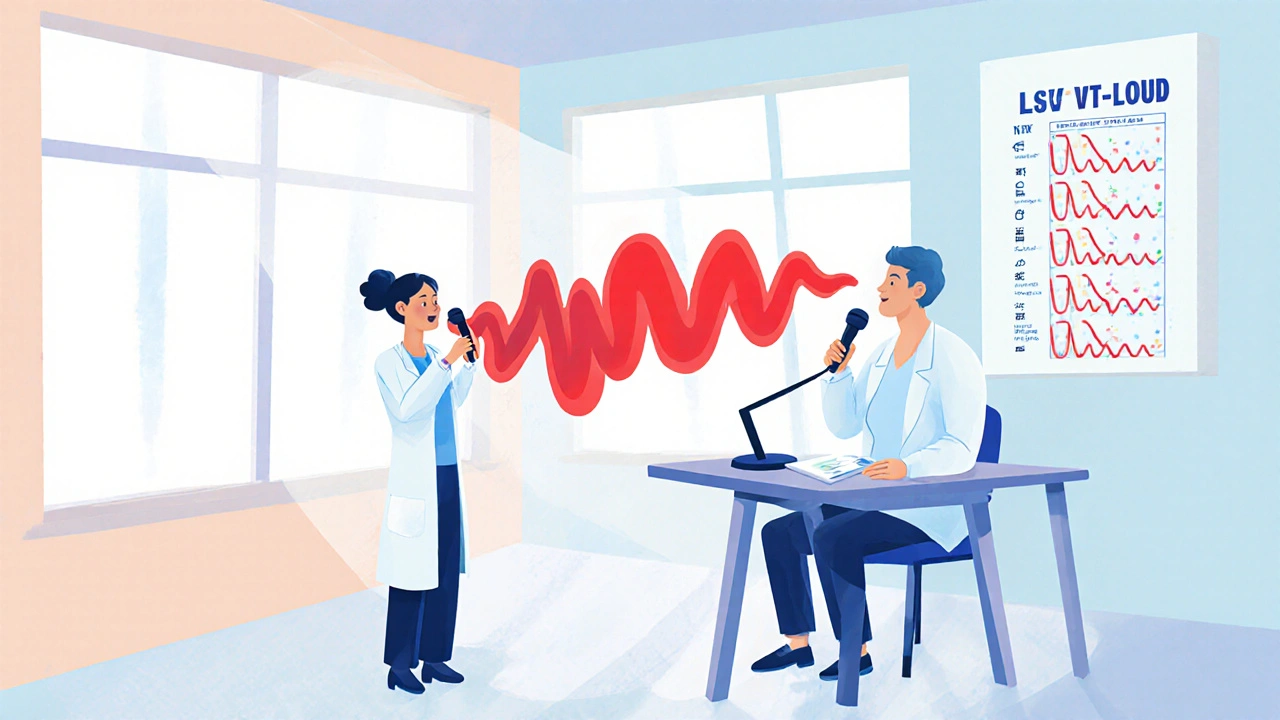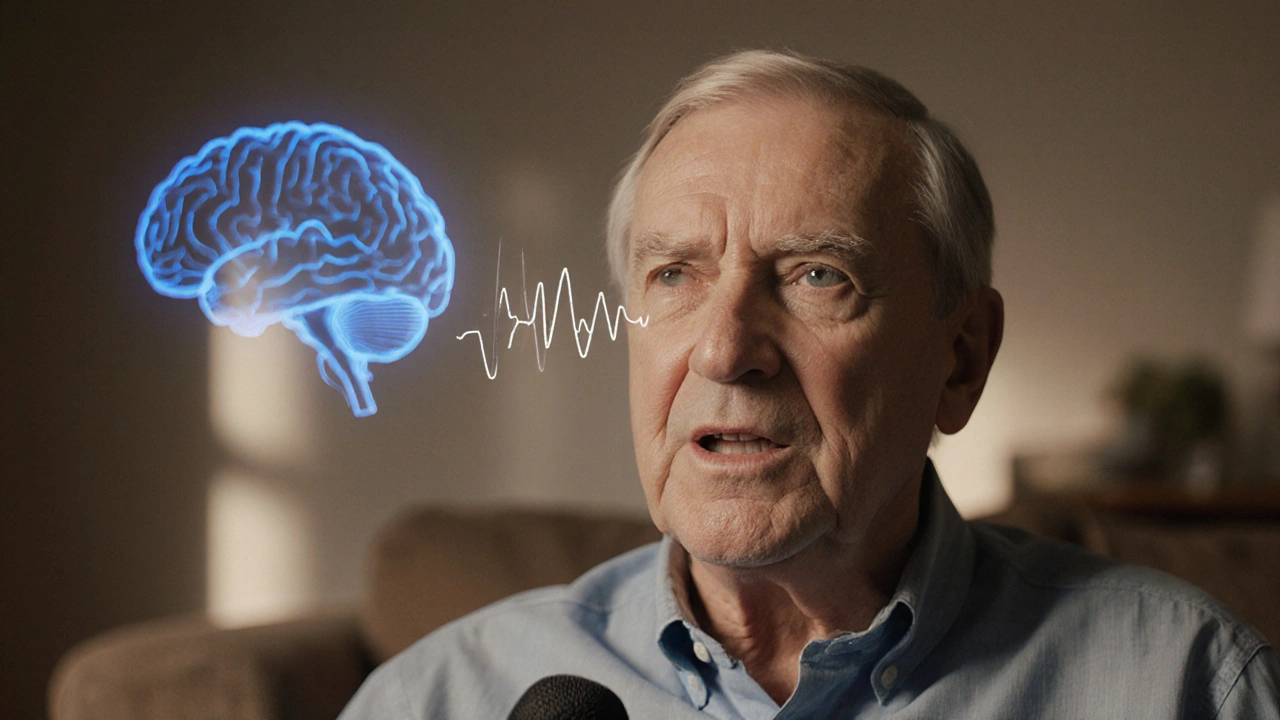Parkinson's Speech Symptom Checker
This tool helps identify common speech symptoms that may occur with Parkinson's disease. These symptoms can significantly impact communication and social interaction.
Hypophonia
Reduced volume or quiet voice, often only audible to the speaker.
Dysarthria
Slurred or imprecise articulation with strained or breathy voice quality.
Monotone Speech
Flat pitch and lack of intonation in speech.
Accelerated Rate
Speaking faster than intended with omitted words.
Hypophonia
What it looks like: Quiet voice, often heard only by the speaker.
Underlying cause: Weak respiratory support and reduced vocal-fold adduction.
This symptom affects up to 90% of people with Parkinson's disease. It occurs due to reduced muscle strength in the respiratory system and vocal folds, making speech sound weak and barely audible.
Dysarthria
What it looks like: Slurred, imprecise articulation; strained or breathy quality.
Underlying cause: Impaired coordination of tongue, lips, and palate.
This symptom makes words difficult to understand. It happens because the muscles controlling speech organs lose coordination, resulting in unclear pronunciation and altered voice quality.
Monotone Speech
What it looks like: Flat pitch, lack of intonation.
Underlying cause: Reduced pitch variability from vocal-fold tension changes.
People with monotone speech often sound emotionless or flat. This happens because the ability to vary pitch is affected by changes in vocal fold tension and movement.
Accelerated Rate
What it looks like: Speaking faster than intended, often with omitted words.
Underlying cause: Difficulty initiating and terminating speech bursts.
This symptom causes rapid, rushed speech that can be hard to follow. It results from motor timing issues in the brain that affect the rhythm of speech production.
Communication Tips for Family Members
- Reduce background noise: Turn off the TV or radio when talking one-on-one.
- Face the speaker: Maintain eye contact to help with visual cues.
- Encourage pauses: Let the person take a breath before responding.
- Repeat gently: Repeat or rephrase instead of finishing sentences for them.
- Use written reminders: Notes for tasks that become verbally tricky.
These strategies can make conversations easier and more enjoyable for everyone involved.
When Parkinson's disease is a progressive neurodegenerative disorder that primarily impairs motor function, it also sneaks into the way people talk and connect.
Quick Takeaways
- Speech changes affect up to 90% of people with Parkinson's disease.
- The most common problems are reduced volume (hypophonia) and slurred articulation (dysarthria).
- Early intervention with speech‑language therapy can preserve intelligibility and confidence.
- Medication adjustments and deep brain stimulation may improve vocal control for some patients.
- Family members benefit from simple communication strategies to reduce frustration.
Why Speech Takes a Hit
Speech relies on precise timing, muscle strength, and smooth coordination of the lungs, vocal folds, and articulators. In Parkinson's disease, the loss of dopamine-producing cells in the basal ganglia disrupts these signals. The result is a cascade of motor deficits that extend from the hands to the face and throat.
The dopamine shortage means the brain can’t “gate” movement properly. Think of dopamine as a traffic light that lets the right signals through at the right moment. Without it, the voice‑producing muscles receive fuzzy commands, leading to reduced vocal intensity, irregular pitch, and slowed speech rate.
Key Speech Symptoms
Most clinicians group Parkinson's‑related speech problems into a few recognizable patterns:
| Symptom | What It Looks Like | Underlying Cause |
|---|---|---|
| Hypophonia | Quiet voice, often heard only by the speaker | Weak respiratory support and reduced vocal‑fold adduction |
| Dysarthria | Slurred, imprecise articulation; strained or breathy quality | Impaired coordination of tongue, lips, and palate |
| Monotone Speech | Flat pitch, lack of intonation | Reduced pitch variability from vocal‑fold tension changes |
| Accelerated Rate | Speaking faster than intended, often with omitted words | Difficulty initiating and terminating speech bursts |

How Communication Is Affected
When speech degrades, the ripple effect hits everyday conversation. Friends may ask, “Can you hear me?” and family members might repeat themselves, creating a frustrating loop. Over time, many people with Parkinson's withdraw from social settings-not because they don’t want to talk, but because they fear being misunderstood.
Research from the International Parkinson and Movement Disorder Society in 2023 showed that 42% of participants reported reduced social participation after speech problems emerged. The emotional toll can manifest as anxiety, depression, and a sense of isolation.
Speech‑Language Pathology: A First Line of Defense
Speech therapy, often delivered by a certified speech‑language pathologist (SLP), targets the core motor deficits. One popular approach is the Lee Silverman Voice Treatment (LSVT‑LOUD), a high‑intensity program that focuses on boosting vocal effort.
Typical LSVT‑LOUD sessions include:
- Maximum‑effort phonation drills (e.g., sustained “ah” at a loud volume).
- Pitch‑range exercises to restore intonation.
- Breathing coordination drills to improve support.
- Functional conversation practice with real‑life scripts.
Studies consistently report a 10-15 dB increase in vocal intensity after four weeks of daily practice, and many patients retain gains for up to six months without reinforcement.
Medication and Surgical Options
Levodopa remains the cornerstone of Parkinson's management. While it primarily eases limb rigidity, it can also raise vocal loudness by restoring dopamine pathways involved in speech. However, the effect varies; some patients notice only marginal improvements.
For those with limited response to medication, deep brain stimulation (DBS) offers an alternative. By delivering electrical pulses to the subthalamic nucleus or globus pallidus interna, DBS can smooth out motor timing, sometimes translating into clearer speech. Yet, DBS may also cause speech side‑effects in a minority of cases, so careful monitoring is essential.

Practical Tips for Families and Caregivers
Even without professional therapy, simple adjustments can make conversation smoother:
- Reduce background noise: Turn off the TV or radio when talking one‑on‑one.
- Face the speaker directly and maintain eye contact; visual cues help fill in missing words.
- Encourage the person to pause and take a breath before responding.
- Repeat or rephrase gently instead of finishing sentences for them.
- Use written reminders (e.g., a note with key phone numbers) for tasks that become verbally tricky.
These small habits preserve dignity and keep the conversation flowing.
Future Directions in Research
Scientists are exploring novel ways to preserve speech pathways. Recent trials of focused ultrasound targeting the thalamus showed promising short‑term gains in voice volume without the invasiveness of DBS. Another emerging field is digital speech monitoring, where smartphone apps record daily speech samples and use AI to flag subtle declines before they become noticeable.
Early detection could trigger timely therapy adjustments, potentially slowing the communication decline that accompanies disease progression.
Bottom Line
Speech and communication are often the first casualties of Parkinson's disease, but they are also the most treatable. Parkinson's disease speech issues can be mitigated with early, targeted speech‑language therapy, thoughtful medication management, and supportive communication strategies at home. Staying proactive turns a daunting symptom into a manageable part of living with Parkinson's.
Frequently Asked Questions
How early should speech therapy start after a Parkinson's diagnosis?
Ideally within the first six months. Early intervention capitalizes on residual motor function and often prevents severe hypophonia from taking hold.
Can levodopa improve my voice?
Levodopa can raise vocal loudness for many patients, but the response is variable. It works best when combined with voice‑focused exercises.
Is deep brain stimulation a cure for speech problems?
DBS is not a cure, but it can reduce motor fluctuations that affect speech timing. Some users report clearer speech, while others may experience new articulation issues, so personalized programming is key.
What home exercises help with hypophonia?
Try the "500‑ml water” drill: take a deep breath, say “ah” loudly for the duration it takes to finish a 500‑ml glass of water, and repeat five times daily.
Can technology assist in monitoring speech changes?
Yes. Mobile apps equipped with speech‑analysis algorithms can track volume, pitch, and articulation speed, alerting patients and clinicians to subtle declines.


Jillian Rooney
October 9, 2025 AT 22:09Ignoring the speech challenges of Parkinson's patients is a moral failing that our culture can’t afford. When a person’s voice drowns out in a crowded room, it isn’t just a medical issue-it’s a societal neglect that we must confront.
Rex Peterson
October 19, 2025 AT 04:22The phenomenology of speech impairment in Parkinsonian pathology invites a contemplation of embodiment and agency. As the vocal apparatus falters, the subject’s capacity for self‑expression is constrained, prompting an ethical imperative to restore communicative autonomy through interdisciplinary intervention.
Candace Jones
October 28, 2025 AT 10:36If you’re looking for practical steps, start with breath‑support exercises; inhaling deeply and sustaining a steady “ah” for several seconds can gradually strengthen the respiratory muscles. Pair this with the LSVT‑LOUD protocol, which emphasizes maximum‑effort phonation to counteract hypophonia.
Robert Ortega
November 6, 2025 AT 16:49Many families find that simply reducing background noise makes a huge difference; turning off the TV while talking lets the person focus on auditory feedback. Maintaining eye contact and encouraging pauses also help the speaker gather breath and formulate words more clearly.
Elizabeth Nisbet
November 15, 2025 AT 23:02This info is gold!
Sydney Tammarine
November 25, 2025 AT 05:16Honestly, the way we dismiss these struggles feels like a betrayal of our own humanity 😤.
josue rosa
December 4, 2025 AT 11:29The neurophysiological underpinnings of dysarthria involve disrupted corticobulbar pathways, which impair the precise timing required for coordinated phonemic articulation. This desynchronization manifests as slurred speech and reduced vocal intensity, often compounding the psychosocial burden on patients. Therapeutic interventions must therefore target both motor execution and perceptual feedback loops. Studies have shown that intensive speech‑language pathology, delivered in a high‑frequency schedule, can recalibrate these neural circuits via neuroplastic mechanisms. Moreover, adjunctive pharmacologic modulation, such as optimizing levodopa dosing, may enhance the responsiveness of the basal ganglia to speech‑motor commands. It is essential for clinicians to adopt a multimodal assessment framework, incorporating acoustic analysis, patient‑reported outcomes, and caregiver observations. By integrating these data streams, treatment plans become personalized, addressing the heterogeneity of symptom expression across the Parkinsonian population.